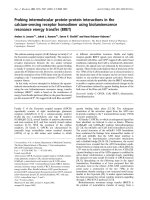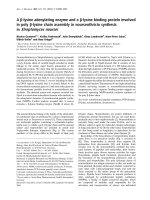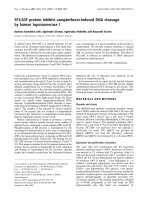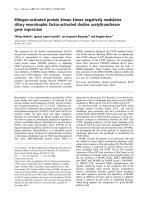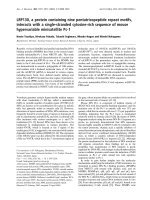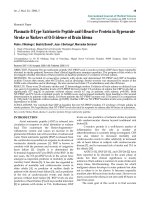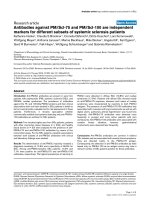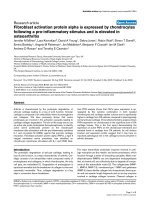Báo cáo y học: "Positive anti-citrullinated protein antibody status and small joint arthritis are consistent predictors of chronic disease in patients with very early arthritis: results from the NOR-VEAC cohort" pot
Bạn đang xem bản rút gọn của tài liệu. Xem và tải ngay bản đầy đủ của tài liệu tại đây (193.03 KB, 8 trang )
Open Access
Available online />Page 1 of 8
(page number not for citation purposes)
Vol 11 No 5
Research article
Positive anti-citrullinated protein antibody status and small joint
arthritis are consistent predictors of chronic disease in patients
with very early arthritis: results from the NOR-VEAC cohort
Maria D Mjaavatten
1
, Till Uhlig
1
, Anne J Haugen
2
, Halvor Nygaard
3
, Göran Sidenvall
4
,
Knut Helgetveit
5
and Tore K Kvien
1
1
Department of Rheumatology, Diakonhjemmet Hospital, P.O. box 23 Vinderen, 0319 Oslo, Norway
2
Department of Rheumatology, Østfold Hospital Trust, 1603 Fredrikstad, Norway
3
Lillehammer Hospital for Rheumatic Diseases, Margrethe Grundtvigs vei 6, 2609 Lillehammer, Norway
4
Department of Rheumatology, Innlandet Hospital, 2226 Kongsvinger, Norway
5
Martina Hansen Hospital, P.O. box 23, 1306 Bærum Postal Terminal, Norway
Corresponding author: Maria D Mjaavatten,
Received: 12 May 2009 Revisions requested: 8 Jul 2009 Revisions received: 21 Sep 2009 Accepted: 1 Oct 2009 Published: 1 Oct 2009
Arthritis Research & Therapy 2009, 11:R146 (doi:10.1186/ar2820)
This article is online at: />© 2009 Mjaavatten et al.; licensee BioMed Central Ltd.
This is an open access article distributed under the terms of the Creative Commons Attribution License ( />),
which permits unrestricted use, distribution, and reproduction in any medium, provided the original work is properly cited.
Abstract
Introduction The current 1987 American College of
Rheumatology (ACR) classification criteria for rheumatoid
arthritis (RA) have proven less useful in early arthritis. The
objective of this study was to identify and compare predictors of
three relevant outcomes of chronic arthritis in a cohort of very
early arthritis patients.
Methods The Norwegian Very Early Arthritis Cohort (NOR-
VEAC) includes adult patients with at least one swollen joint of
≤16 weeks' duration. Patients are followed for 2 years with
comprehensive clinical and laboratory examinations. Logistic
regression analyses were performed to determine independent
predictors of three outcomes: persistent synovitis, prescription
of disease-modifying anti-rheumatic drugs (DMARDs), and
established clinical RA diagnosis within one year.
Results Of 384 patients eligible for one year follow-up (56.3%
females, mean (SD) age 45.8 (14.7) years, median (IQR)
duration of arthritis 31 (10-62) days), 14.4% were anti-CCP2
positive, and 11.2% were IgM RF positive. 98 patients (25.5%)
had persistent synovitis, 106 (27.6%) had received DMARD
treatment during follow-up, while 68 (17.7%) were diagnosed
with RA. Consistent independent predictors across all three
outcomes were positive anti-citrullinated protein antibody
(ACPA) status (odds ratio (OR) 3.2, 5.6 and 19.3), respectively,
and small joint arthritis (proximal interphalangeal joint (PIP),
metacarpo-phalangeal joint (MCP), and/or metatarso-
phalangeal joint (MTP) joint swelling) (OR 1.9, 3.5, and 3.5,
respectively).
Conclusions Positive ACPA status and small joint arthritis were
consistent predictors of three relevant outcomes of chronic
arthritis in very early arthritis patients. This consistency supports
DMARD prescription as a valid surrogate endpoint for chronic
arthritis. Importantly, this surrogate is used in ongoing efforts to
develop new diagnostic criteria for early RA.
Introduction
The 1987 American College of Rheumatology (ACR) classifi-
cation criteria for rheumatoid arthritis (RA) were designed to
ensure that patients included in clinical trials were true RA
patients, and the criteria have been of major importance to
clinical research in rheumatology [1]. However, the criteria
were never intended to be used for RA diagnosis, and many
studies have shown that the existing criteria lack sensitivity
and are more useful in established rather than early arthritis [2-
5]. Nevertheless, the criteria have been widely used in the clin-
ical setting, even in the assessment of patients with recent-
onset arthritis, and it can be assumed that rheumatologists
ACPA: anti-citrullinated protein antibody; ACR: American College of Rheumatology; CCP: cyclic citrullinated peptide; CRP: C-reactive protein;
DMARDs: disease-modifying anti-rheumatic drugs; ELISA: enzyme-linked immunosorbent assay; ESR: erythrocyte sedimentation rate; EULAR: Euro-
pean League Against Rheumatism; HAQ: Health Assessment Questionnaire; MCP: metacarpo-phalangeal joint; MTP: metatarso-phalangeal joint;
NOR-VEAC: Norwegian Very Early Arthritis Cohort; PIP: proximal interphalangeal joint; RA: rheumatoid arthritis; RADAI: Rheumatoid Arthritis Disease
Activity Index; RF: rheumatoid factor; SF-36: Short Form Health Survey; SJC: small joint count; TJC: tender joint count; VAS: visual analogue scale.
Arthritis Research & Therapy Vol 11 No 5 Mjaavatten et al.
Page 2 of 8
(page number not for citation purposes)
often consider the fulfilment of these criteria when evaluating
the diagnosis and/or prognosis in their arthritis patients [6].
Features such as erosions and rheumatoid nodules reflect
established disease and their value as part of the criteria is
questioned in the era of early aggressive treatment, when the
aim is to treat patients before bone damage occurs.
Several authors have called for new classification criteria [7-
9]. The target patient group in which potential new criteria will
be applied is probably wider and more diverse than patients
fulfilling the current ACR criteria alone. Persistent synovitis as
a marker of chronic disease is also an outcome of interest in
early inflammatory arthritis [10-12], although RA development
in itself is important to predict. An ongoing European League
Against Rheumatism (EULAR)/ACR task force aims to define
a set of criteria for the diagnosis of early RA [13]. To avoid cir-
cularity, the task force has proposed to use the start of
DMARD therapy as a surrogate endpoint in the data-driven
process of developing new candidate criteria. The rationale
behind this approach is derived from the hypothesis that the
physician at the time of a disease-modifying anti-rheumatic
drug (DMARD) prescription assumes the patient to be at high
risk of developing chronic and severe disease.
The purpose of this study was to determine predictors of three
relevant outcomes in early arthritis: persistent joint swelling,
DMARD prescription, and RA development.
Materials and methods
Early arthritis clinic
The Norwegian Very Early Arthritis Clinic (NOR-VEAC) study
was started in 2004 as a multicenter observational study in the
South-Eastern part of Norway. The five participating hospitals
serve a region with approximately 1.7 million inhabitants. The
cohort includes patients (age 18 to 75 years) presenting with
at least one clinically swollen joint of 16 weeks' duration or
less, and patients are followed longitudinally for two years.
Patients with joint swelling due to trauma, osteoarthritis, crys-
tal arthropathies, and septic arthritis are excluded from follow-
up. The study was approved by the regional Ethics Board and
the Data Inspectorate, and patients gave informed consent.
Data collection
Data collection was performed by rheumatologists and desig-
nated study nurses in the five different centers. Registration
included age, sex, duration of symptoms, co-morbidities, extra-
articular symptoms, level of education, occupational status,
smoking and coffee drinking habits, height and weight. Sixty-
eight swollen joint counts (SJC) and 28 tender joint counts
(TJC) were performed by a rheumatologist or by experienced
study nurses. Patient-reported outcomes included joint pain,
fatigue, and global health status on visual analogue scales
(VAS), the Norwegian versions of the Health Assessment
Questionnaire (HAQ) [14], and Short Form Health Survey (SF-
36) with aggregated physical and mental component summary
scores [15,16]. Information about morning stiffness (duration)
was captured from the Rheumatoid Arthritis Disease Activity
Index (RADAI) [17]. The assessor reported global evaluation
of disease activity on a VAS. Erythrocyte sedimentation rate
(ESR) and C-reactive protein (CRP) levels were determined at
the local laboratories. Serum was frozen and stored at -70°C
and analysed in one batch for anti-citrullinated protein antibod-
ies (ACPA; anti-CCP2
®
, INOVA Diagnostics, Inc. San Diego,
CA, USA) and IgM rheumatoid factor (RF; using ELISA). The
cut-off levels for positivity of serologic markers recommended
by the central laboratory were employed, as also reported pre-
viously (anti-CCP2 ≥25 units/ml, IgM RF ≥25 IU/ml) [18].
Outcome variables
Patients eligible for one year of follow-up time by 1 January,
2008, were included in the current analyses. Persistent syno-
vitis was defined as presence of one or more swollen joints on
at least two out of three follow-up assessments during the first
year. Synovitis did not have to be present in the same joint on
consecutive assessments. Patients lost to follow-up with less
than two recorded follow-up visits were assumed to have non-
persistent arthritis. A clinical diagnosis of RA was recorded by
the treating rheumatologist, and diagnosis was therefore not
restricted to fulfilment of the ACR classification criteria. Infor-
mation about DMARD prescription was collected through
chart review, and start of DMARD(s) during the first year and
DMARD type were recorded. Patients lost to follow-up were
assumed to neither have RA nor have received DMARD treat-
ment after the last recorded visit.
Statistical analysis
Means and standard deviations were calculated for continu-
ous variables following a Gaussian distribution, otherwise
median values and interquartile ranges (25th to 75th percen-
tiles) were calculated. Multiple logistic regression analyses
were used to determine baseline variables independently
associated with each outcome (dependent variables). The
independent variables were selected from univariate analyses
if P < 0.25. The model building process was performed
according to the methods described by Hosmer and Leme-
show [19]. Sex, ACPA status, RF status, morning stiffness
lasting less than one hour, presence of joint swelling in either
metacarpo-phalangeal joint (MCP), proximal interphalangeal
joint (PIP), or metatarso-phalangeal joint joint (MTP) joint(s)
(small joint arthritis), and smoking status (never/ever) were
entered as dichotomous variables. The following variables
were entered as continuous measures in the regression anal-
yses: age, 68-SJC, 28-TJC, ESR, CRP, HAQ. All tests were
conducted at the 0.05 significance level. Analyses were per-
formed using SPSS 14.0 (SPSS, Chicago, IL, USA).
Available online />Page 3 of 8
(page number not for citation purposes)
Results
Demographic, clinical and biological characteristics
Baseline characteristics of the 384 patients with early arthritis
included in the present analyses are reported in Table 1. The
duration of joint swelling at inclusion was very short (median
31 days), and 14.3% were ACPA positive and 11.4% were
IgM positive. Percentages of ACPA/IgM RF positive patients
in each of the groups according to outcome were: persistent
arthritis 35.2/26.7, DMARD prescription 41.5/31.5, and RA
58.8/49.2. Corresponding percentages of patients with ele-
vated ESR/CRP in the different outcome groups were 59.8/
55.1, 67.9/59.4, and 61.8/51.5, respectively. Monoarthritis at
presentation was seen in 146 (38%) patients, 130 (33.9%)
patients had two to four swollen joints (oligoarthritis), and 108
(28.1%) patients presented with polyarthritis. Twenty-four
(16%) patients in the persistent arthritis group, 5 (3%)
patients in the RA group and 17 (16%) patients in the DMARD
prescription group presented with monoarthritis. The knee
joint was the most frequently involved single joint (39.1%), fol-
lowed by the ankle (32.3%) and wrist (30.2%) joints. Small
joints in hands and feet were involved in 43.8% of patients.
Of 384 included patients, 287 (75%) completed the one year
follow-up. Recorded reasons for drop-out (number of patients)
were remission (43), lost contact with patient (24), other diag-
noses (6), patient moved (2), other (2), and unknown (20).
Frequency of outcomes
A total of 146 patients had one or more of the assessed out-
comes at one year. The distribution of patients by outcome is
depicted in Figure 1. Forty patients (10.4%) had all three out-
comes. Only seven patients with RA had not been prescribed
DMARD treatment during the first year, compared with 33
patients with persistent synovitis, whereas 45 (12%) patients
were prescribed DMARD therapy without a RA diagnosis.
Although 68 (17.7%) patients had a RA diagnosis at one year,
an additional 78 (20.3%) patients had either persistent syno-
vitis or had received DMARD therapy, and thus had a chronic
inflammatory joint condition without being diagnosed with RA.
None of the outcomes were seen in 238 patients. The distri-
bution of diagnoses during follow-up in these patients were
(last observation carried forward): undifferentiated arthritis
118 (49.6%), reactive arthritis 52 (21.8%), sarcoidosis-
related arthritis/Löfgren's syndrome 44 (18.5%), psoriatic
arthritis 11 (4.6%), osteoarthritis 5 (2.1%), gout 2 (0.8%), and
other 6 (2.5%).
Table 1
Baseline characteristics of 384 patients with early arthritis
Mean (SD)/n (%) Median (IQR)
Female gender 217 (56.5)
Age (years) 45.8 (14.7) 44.8 (34.7-58.1)
Arthritis duration (days) 38.0 (30.0) 31 (10-62)
SJC (0-68) 4.5 (6.7) 2.0 (1-5)
TJC (0-28) 3.2 (5.0) 1.0 (0-4)
ESR (mm/h) 31 (24) 24 (12-48)
ESR >20 mm/h 214 (56.0)
CRP (mg/l) 32 (47) 15 (5-43)
CRP >10 mg/l 224 (58.3)
IgM RF positive 38 (11.4)
ACPA positive 49 (14.3)
Assessor's global VAS (mm) 36 (21) 32 (19-50)
Patient's global VAS (mm) 52 (25) 53 (35-71)
Joint pain VAS (mm) 51 (26) 52 (29-72)
Fatigue VAS (mm) 40 (29) 40 (11-65)
Morning stiffness >1 hour 195 (50.8)
DAS28 4.01 (1.34) 3.90 (3.06-4.82)
HAQ (0-3) 0.84 (0.67) 0.75 (0.25-1.25)
SF-36:
PCS 33.4 (10.8) 32.8 (25.1-40.4)
MCS 48.6 (11.4) 50.4 (40.1-57.4)
Ever smoker 236 (61.5)
Number of patients with missing data: SJC/TJC 0, CRP 0, ESR 2,
HAQ 9, CCP 42, IgM RF 51, smoking 3, morning stiffness 9, small
joints 0.
ACPA = anti-citrullinated protein antibody; CRP = C-reactive
protein; DAS = Disease Activity Score; ESR = erythrocyte
sedimentation rate; HAQ = Health Assessment Questionnaire; IQR
= inter-quartile range; MCS = Mental Component Summary; PCS =
Physical Component Summary; RF = rheumatoid factor; SD =
standard deviation; SF-36 = Short Form Health Survey; SJC =
swollen joint count; TJC = tender joint count; VAS = visual analogue
scale.
Figure 1
Persistent synovitis, DMARD prescription, and rheumatoid arthritis diagnosis as one-year outcomes in 384 patients with very early arthritisPersistent synovitis, DMARD prescription, and rheumatoid arthritis
diagnosis as one-year outcomes in 384 patients with very early arthritis.
DMARD = disease-modifying anti-rheumatic drugs.
Arthritis Research & Therapy Vol 11 No 5 Mjaavatten et al.
Page 4 of 8
(page number not for citation purposes)
Persistent synovitis
Ninety-eight (25.5%) patients had persistent synovitis during
follow-up. Joint counts, positive ACPA or RF status, morning
stiffness, HAQ, and higher age were factors associated with
persistent synovitis in the univariate analyses (Table 2). Inde-
pendent predictors of persistent synovitis were positive ACPA
status, involvement of small joints in hands and/or feet and
HAQ. A higher CRP at presentation was unexpectedly protec-
tive of having persistent synovitis throughout the first year (P =
0.05; Table 3).
DMARD prescription
Treatment with DMARDs was initiated during the first year in
106 (27.6%) patients. Methotrexate was the predominant
drug of choice, and was given as monotherapy in 64 (16.7%)
patients. Biological agents were given to 13 patients, all in
combination with methotrexate. Sulphasalazine was pre-
scribed in 10 (2.6%) patients, leflunomide monotherapy in 1
patient, and combinations of traditional DMARDs were given
in 18 (4.7%) patients. Joint counts, ACPA, RF, morning stiff-
ness, HAQ, and small joint arthritis were univariately associ-
ated with initiation of DMARD therapy during follow-up (Table
2). Multivariate regression analysis showed that ACPA positiv-
ity, small joint arthritis, and HAQ were independent predictors
of DMARD prescription. Tender joint count also contributed to
the final model shown in Table 3.
Rheumatoid arthritis
Of the 68 (17.7%) patients who were diagnosed with RA
within the first year of follow-up, 36 were diagnosed at the first
visit. Univariate associations were significant for the same var-
iables for RA as for persistent synovitis, with the addition of
smoking (Table 2). The multivariate regression model (Table 3)
showed that age, ACPA, RF, tender joint count and small joint
involvement were independently associated with a RA diagno-
sis within the first year of follow-up. Evidence of confounding
between the serologic markers was found as removal of RF
resulted in an increase in the regression coefficient of ACPA
exceeding 15%.
A general perception is that patients with monoarthritis rarely
develop RA. Our results regarding predictors for RA were
maintained also in a reanalyses of the cohort after excluding
the patients with monoarthritis at baseline (data not shown).
Discussion
Identification of patients with recent-onset arthritis at high risk
of developing chronic arthritis is an important clinical chal-
lenge, because individual management of early arthritis should
be based on the expected disease course. One particular dif-
ficulty is to decide the most relevant outcome when prediction
models are developed in undifferentiated patient populations.
RA development is probably not the only important endpoint,
Table 2
Prediction of persistent synovitis, DMARD prescription and RA at one year in univariate logistic regression analyses
Dependent variable
Persistent synovitis
n = 98
DMARD prescription
n = 106
RA
n = 68
Baseline variables OR (95% CI) P value OR (95% CI) P value OR (95% CI) P value
Age (years) 1.02 (1.01-1.04) 0.008* 1.02 (1.00-1.04) 0.017* 1.05 (1.03-1.07) < 0.001*
Female gender 1.46 (0.91-2.33) 0.12* 1.06 (0.67-1.67) 0.80 1.12 (0.67-1.91) 0.67
68-SJC 1.08 (1.03-1.12) < 0.001* 1.14 (1.09-1.20) < 0.001* 1.15 (1.09-1.21) < 0.001*
28-TJC 1.11 (1.06-1.16) < 0.001* 1.19 (1.13-1.26) < 0.001* 1.20 (1.13-1.27) < 0.001*
ESR (mm/h) 1.00 (1.00-1.01) 0.41 1.01 (1.00-1.02) 0.09* 1.00 (0.99-1.01) 0.98
CRP (mg/l) 1.00 (0.99-1.00) 0.18* 1.00 (1.00-1.01) 0.80 1.00 (0.99-1.00) 0.23*
ACPA positivity 7.13 (3.73-13.64) < 0.001* 16.9 (7.94-35.8) < 0.001* 57.6 (24.6-134.5) < 0.001*
IgM RF positivity 5.65 (2.78-11.5) < 0.001* 11.8 (5.34-26.4) < 0.001* 28.5 (12.3-65.8) < 0.001*
Morn. stiffness >1 hour 1.74 (1.08-2.79) 0.023* 2.71 (1.68-4.38) < 0.001* 2.47 (1.40-4.37) 0.002*
HAQ (0-3) 1.61 (1.15-2.27) 0.006* 2.22 (1.57-3.14) < 0.001* 1.63 (1.11-2.39) 0.012*
Small joint arthritis
§
3.72 (2.29-6.05) < 0.001* 8.19 (4.83-13.9) < 0.001* 20.5 (8.58-48.9) < 0.001*
Ever smoker 1.19 (0.74-1.92) 0.48 1.33 (0.83-2.13) 0.24* 2.71 (1.44-5.09) 0.002*
§
Metacarpo-phalangeal joint, proximal interphalangeal joint, or metatarso-phalangeal joint joint swelling.*P < 0.25, variable selected for inclusion
in multivariate analyses.
ACPA = anti-citrullinated protein antibody; CI = confidence interval; CRP = C-reactive protein; DMARD = disease-modifying anti-rheumatic
drugs; ESR = erythrocyte sedimentation rate; HAQ = Health Assessment Questionnaire; OR = odds ratio; RA = rheumatoid arthritis; RF =
rheumatoid factor; SJC = swollen joint count; TJC = tender joint count.
Available online />Page 5 of 8
(page number not for citation purposes)
as some patients with undifferentiated, persistent arthritis have
been shown to have a prognosis similar to RA patients [20].
The clinical utility of prediction models is presumably
enhanced if predictors are similar across several relevant end-
points. In the present study, we found that ACPA and arthritis
of joints in fingers or toes were consistent predictors regard-
less of whether the outcome was persistent synovitis, start of
DMARD treatment, or RA diagnosis.
Some previous studies have identified ACPA as a significant
predictor of transition from undifferentiated arthritis to RA [21-
23]. A study in undifferentiated arthritis conducted without
measuring ACPA found RF to be predictive of RA [24]. Van
der Helm-van Mil and colleagues found individual contribution
of both RF and anti-CCP to RA development in their study
[22]. This is in line with our findings, where both RF and ACPA
were independently associated with RA diagnosis. For RA,
both RF and anti-CCP have been found to be present in pre-
morbid sera several years before disease start, and these
biomarkers are therefore especially important in very early
arthritis [25-27]. Results of the PROMPT study even sug-
gested that ACPA-positive early arthritis is a distinct disease
entity whose prognosis can be altered by early treatment with
methotrexate [28].
Arthritis of the hand joints is part of the original classification
criteria for RA [1]. Emery and colleagues recognised arthritis
of the MTP joints, diagnosed by the so-called squeeze test, as
a clinical sign requiring early referral to a rheumatologist for
evaluation of possible RA [29]. This led us to investigate the
separate predictive capacity of the involvement of small joints
inhand and feet joints. We found that small joint involvement of
hands and feet were separately weaker predictors across all
three outcomes than hands and feet combined (data not
shown).
Prescription of DMARD therapy in early arthritis has also been
previously used as a surrogate for chronic arthritis, but Quinn
and colleagues were unable to find baseline predictors for this
endpoint [24]. According to the 'window-of-opportunity'
hypothesis, DMARD treatment should ideally be initiated
within three months of symptom onset in high-risk patients
[30]. It is therefore crucial to define predictive characteristics
that are present at a very early stage of disease. The NOR-
VEAC cohort has median arthritis duration of only 31 days,
and this short disease duration, together with the wide inclu-
sion criteria and a comprehensive data collection, offers a
unique opportunity for prediction analysis. However, radio-
graphic data were not available for these patients, and this rep-
resents a limitation of our study. Erosive disease has been
shown to occur early and to predict long-term disability
[31,32]. Prediction of erosive disease is therefore essential,
because DMARD treatment can ameliorate prognosis in high-
risk patients [33-35]. Future follow-up results of the NOR-
VEAC cohort will supplement current knowledge in this field,
as imaging procedures were included in the data collection in
2007.
As data on erosions were not available, fulfilment of the ACR
criteria for RA could not be formally assessed in this study.
Although more subjective, a clinical diagnosis of RA based on
the judgment of an experienced rheumatologist has been
Table 3
Prediction of persistent synovitis, DMARD prescription and RA in final multivariate logistic regression models
Dependent variable
Persistent synovitis
n = 98
DMARD start
n = 106
RA
n = 68
Baseline variables OR (95% CI) P value OR (95% CI) P value OR (95% CI) P value
Age (years) 1.01 (0.99-1.03) 0.18 1.00 (0.98-1.02) 0.70 1.04 (1.01-1.08) 0.018
Female gender 1.20 (0.68-2.12) 0.52 0.99 (0.54-1.79) 0.97 1.24 (0.51-3.01) 0.64
ACPA positivity 4.50 (2.17-9.33) < 0.001 8.11 (3.55-18.6) < 0.001 19.3 (6.84-54.4) < 0.001
IgM RF positivity - - - - 5.02 (1.47-17.1) 0.010
Small joint arthritis
§
2.11 (1.17-3.81) 0.013 3.86 (2.02-7.37) < 0.001 3.45 (1.21-9.90) 0.021
HAQ 1.73 (1.12-2.68) 0.014 1.75 (1.13-2.74) 0.012 - -
28-TJC - - 1.06 (1.00-1.13) 0.064 1.09 (1.02-1.16) 0.012
CRP (mg/l) 0.99 (0.98-1.00) 0.042 - - - -
Constant 0.069 - 0.075 - 0.003 -
§
Metacarpo-phalangeal joint, proximal interphalangeal joint, or metatarso-phalangeal joint joint swelling.
ACPA = anti-citrullinated protein antibody; CI = confidence interval; CRP = C-reactive protein; DMARD = disease-modifying anti-rheumatic
drugs; HAQ = Health Assessment Questionnaire; OR = odds ratio; RA = rheumatoid arthritis; RF = rheumatoid factor; TJC = tender joint count.
Arthritis Research & Therapy Vol 11 No 5 Mjaavatten et al.
Page 6 of 8
(page number not for citation purposes)
shown to be reliable [36], and use of this outcome can cer-
tainly be defended from a clinical point of view.
ACR and EULAR are now developing new classification crite-
ria for early RA. The data-driven part of this process includes
longitudinal data from several early arthritis cohorts, and is
conducted with DMARD start as a surrogate endpoint for
chronic disease. Our results confirm that RA patients and
patients prescribed with DMARDs have common characteris-
tics, and this supports the validity of the strategy. This is further
supported by the fact that in our study patients taking
DMARDs were a larger group than RA patients alone: as many
as 45 patients (11.4%) in our material were prescribed
DMARDs without having received an RA diagnosis (Figure 1).
These patients probably deserve to be recognised by new cri-
teria. The ACR/EULAR task force has decided to only focus on
the subset of patients started on methotrexate. Methotrexate
was the predominant DMARD prescribed in our patients, and
analyses with methotrexate start as the dependent variable
yielded similar results with regard to predictors (data not
shown).
Persistent synovitis as an outcome in early arthritis can be
defined in different ways. Harrison and Symmons studied dif-
ferent outcomes in inflammatory arthritis in the Norfolk Arthritis
Register and defined remission of synovitis as no soft tissue
joint swelling and no treatment with DMARDs or steroids
within the previous three months [10]. RF, tender joint count
more than 6, and presence of ankle synovitis were independ-
ent predictors of persistent synovitis. Visser and colleagues
used a similar definition of 'natural remission' in the Leiden
Early Arthritis Clinic [11]. We chose to define persistent syno-
vitis and DMARD initiation as two separate outcomes. This
approach allowed 23 patients without joint swelling at one
year, but who were on DMARD therapy, to be excluded from
the persistent synovitis group (Figure 1).
However, the independent predictors were similar for both
outcomes which suggests that the difference in our definition
of persistent disease from that used in previous studies had lit-
tle impact on the results with regard to predictors. A higher
CRP at presentation was found to be protective of persistent
synovitis in this study. Although this is contrary to what is gen-
erally reported in the literature, Green and colleagues in their
study of 63 early arthritis patients also found a protective
effect of elevated CRP for persistent arthritis [37]. They sug-
gested that a sub-entity of patients with 'an acute-onset, pol-
yarticular disease, associated with an elevated CRP, that
responds to corticosteroids in the early stages' may exist.
Another possible explanation for the protective effect of CRP
is that patients presenting with monoarthritis of the large joints
tend to have high CRP levels, but are less prone to develop
persistent arthritic disease.
When assessing predictors in early arthritis populations, the
issue of circularity of reasoning is relevant. One can argue that
presence of ACPA and small joint involvement will indeed
influence both the clinician's diagnosis of RA and the decision
to prescribe a DMARD. However, in our cohort, analysis of
anti-CCP was performed as a batch in frozen sera, so knowl-
edge of this biomarker was not routinely available to the clini-
cians at the time of clinical decision-making, although the
clinicians were free to request this analysis as a part of the
work-up. Moreover, the same predictors were also found to be
predictive of an outcome independent of the clinician's knowl-
edge of these factors, namely persistent joint swelling. We
believe that the use of this additional outcome in our study
adds to the validity of the results.
Conclusions
A few studies have investigated predictors of several different
outcomes in early arthritis, but as far as we know, this study is
the first to identify consistent predictors of both RA, DMARD
prescription, and persistent synovitis. In conclusion, our
results show that ACPA positive early arthritis with involve-
ment of small joints in the extremities is likely to progress to
persistent disease. As well as supporting the approach cho-
sen by the ACR/EULAR task force in defining new criteria, our
study emphasises the need for new criteria for early inflamma-
tory arthritis. Sixty-eight patients in our material were diag-
nosed with RA during one year of follow-up. More importantly,
an additional 78 patients (20%) either received DMARD ther-
apy or had persistent joint swelling on repeated assessments
without receiving a RA diagnosis. These patients should prob-
ably be recognised within the framework of new criteria.
Competing interests
The authors declare that they have no competing interests.
Authors' contributions
MDM performed the statistical analyses and drafted the man-
uscript, as well as participating in the study design. TU helped
to draft the manuscript and participated in the data collection.
AJH, HN, and KH participated in the study design and data
collection. GS participated in the data collection. TKK was the
main designer of the study and helped draft the manuscript. All
authors read and approved the final manuscript.
Acknowledgements
The authors thank the patients for participating in this study, the Norwe-
gian Foundation for Health and Rehabilitation and Eastern Norway
Regional Health Authority for funding, and the local rheumatology staff
for data collection. We would also like to thank Per Ivar Gaarder and Gro
Jaaberg Talgø at the Department of Immunology and Transfusion Medi-
cine, Ullevål University Hospital for performing the analyses of RF and
anti-CCP, and Inova Inc. for providing the kits for analysing anti-CCP.
We are grateful to Inge C. Olsen for helpful discussions regarding the
statistical analyses.
Available online />Page 7 of 8
(page number not for citation purposes)
References
1. Arnett FC, Edworthy SM, Bloch DA, McShane DJ, Fries JF, Cooper
NS, Healey LA, Kaplan SR, Liang MH, Luthra HS, Medsger TA,
Mitchell DM, Neustadt DH, Pinals RS, Schaller JG, Sharp JT,
Wilder RL, Hunder GG: The American Rheumatism Association
1987 revised criteria for the classification of rheumatoid
arthritis. Arthritis Rheum 1988, 31:315-324.
2. Harrison BJ, Symmons DP, Barrett EM, Silman AJ: The perform-
ance of the 1987 ARA classification criteria for rheumatoid
arthritis in a population based cohort of patients with early
inflammatory polyarthritis. American Rheumatism
Association. J Rheumatol 1998, 25:2324-2330.
3. Kaarela K, Kauppi MJ, Lehtinen KE: The value of the ACR 1987
criteria in very early rheumatoid arthritis. Scand J Rheumatol
1995, 24:279-281.
4. Lunt M, Symmons DP, Silman AJ: An evaluation of the decision
tree format of the American College of Rheumatology 1987
classification criteria for rheumatoid arthritis: performance
over five years in a primary care-based prospective study.
Arthritis Rheum 2005, 52:2277-2283.
5. Saraux A, Berthelot JM, Chales G, Le Henaff C, Thorel JB, Hoang
S, Valls I, Devauchelle V, Martin A, Baron D, Pennec Y, Botton E,
Mary JY, Le Goff P, Youinou P: Ability of the American College
of Rheumatology 1987 criteria to predict rheumatoid arthritis
in patients with early arthritis and classification of these
patients two years later. Arthritis Rheum 2001, 44:2485-2491.
6. Banal F, Dougados M, Combescure C, Gossec L: Sensitivity and
specificity of the American College of Rheumatology 1987 cri-
teria for the diagnosis of rheumatoid arthritis according to dis-
ease duration: a systematic literature review and meta-
analysis. Ann Rheum Dis 2009, 68:1184-1191.
7. Inanc M: Very early 'Rheumatoid' arthritis cohorts: limited by
selection. Rheumatology (Oxford) 2007, 46:185-187.
8. Scott DL: The diagnosis and prognosis of early arthritis: ration-
ale for new prognostic criteria. Arthritis Rheum 2002,
46:286-290.
9. Symmons DP: Classification criteria for rheumatoid arthritis
time to abandon rheumatoid factor? Rheumatology (Oxford)
2007, 46:725-726.
10. Harrison B, Symmons D: Early inflammatory polyarthritis:
results from the Norfolk Arthritis Register with a review of the
literature. II. Outcome at three years. Rheumatology (Oxford)
2000, 39:939-949.
11. Visser H, le Cessie S, Vos K, Breedveld FC, Hazes JM: How to
diagnose rheumatoid arthritis early: a prediction model for
persistent (erosive) arthritis. Arthritis Rheum 2002,
46:357-365.
12. El Miedany Y, Youssef S, Mehanna AN, El Gaafary M: Develop-
ment of a scoring system for assessment of outcome of early
undifferentiated inflammatory synovitis. Joint Bone Spine
2008, 75:155-162.
13. Aletaha D, Huizinga TW: The use of data from early arthritis clin-
ics for clinical research. Best Pract Res Clin Rheumatol 2009,
23:117-123.
14. Bruce B, Fries JF: The Stanford Health Assessment Question-
naire: dimensions and practical applications. Health Qual Life
Outcomes 2003, 1:20.
15. Loge JH, Kaasa S, Hjermstad MJ, Kvien TK: Translation and per-
formance of the Norwegian SF-36 Health Survey in patients
with rheumatoid arthritis. I. Data quality, scaling assumptions,
reliability, and construct validity. J Clin Epidemiol 1998,
51:1069-1076.
16. Ware JE Jr, Kosinski M, Bayliss MS, McHorney CA, Rogers WH,
Raczek A: Comparison of methods for the scoring and statisti-
cal analysis of SF-36 health profile and summary measures:
summary of results from the Medical Outcomes Study. Med
Care 1995, 33:AS264-AS279.
17. Stucki G, Liang MH, Stucki S, Bruhlmann P, Michel BA: A self-
administered rheumatoid arthritis disease activity index
(RADAI) for epidemiologic research. Psychometric properties
and correlation with parameters of disease activity. Arthritis
Rheum 1995, 38:795-798.
18. Syversen SW, Gaarder PI, Goll GL, Ødegård S, Haavardsholm
EA, Mowinckel P, Heijde DM van der, Landewé R, Kvien TK: High
anti-cyclic citrullinated peptide levels and an algorithm of four
variables predict radiographic progression in patients with
rheumatoid arthritis: results from a 10-year longitudinal study.
Ann Rheum Dis 2008, 67:212-217.
19. Hosmer D, Lemeshow S: Applied Logistic Regression 2nd edition.
New York: John Wiley & Sons, Inc; 2000.
20. Jansen LM, van SD, Horst-Bruinsma IE van der, Dijkmans BA: One
year outcome of undifferentiated polyarthritis. Ann Rheum Dis
2002, 61:700-703.
21. Jansen AL, Horst-Bruinsma IE van der, van Schaardenburg D,
Stadt RJ van de, de Koning MH, Dijkmans BA: Rheumatoid factor
and antibodies to cyclic citrullinated Peptide differentiate
rheumatoid arthritis from undifferentiated polyarthritis in
patients with early arthritis. J Rheumatol 2002, 29:2074-2076.
22. Russell AS, Devani A, Maksymowych WP: The role of anti-cyclic
citrullinated peptide antibodies in predicting progression of
palindromic rheumatism to rheumatoid arthritis. J Rheumatol
2006, 33:1240-1242.
23. Helm-van Mil AH van der, le Cessie S, van Dongen H, Breedveld
FC, Toes RE, Huizinga TW: A prediction rule for disease out-
come in patients with recent-onset undifferentiated arthritis:
how to guide individual treatment decisions. Arthritis Rheum
2007, 56:433-440.
24. Quinn MA, Green MJ, Marzo-Ortega H, Proudman S, Karim Z,
Wakefield RJ, Conaghan PG, Emery P: Prognostic factors in a
large cohort of patients with early undifferentiated inflamma-
tory arthritis after application of a structured management
protocol. Arthritis Rheum 2003, 48:3039-3045.
25. Rantapaa-Dahlqvist S, de Jong BA, Berglin E, Hallmans G, Wadell
G, Stenlund H, Sundin U, van Venrooij WJ: Antibodies against
cyclic citrullinated peptide and IgA rheumatoid factor predict
the development of rheumatoid arthritis. Arthritis Rheum 2003,
48:2741-2749.
26. Jorgensen KT, Wiik A, Pedersen M, Hedegaard CJ, Vestergaard
BF, Gislefoss RE, Kvien TK, Wohlfahrt J, Bendtzen K, Frisch M:
Cytokines, autoantibodies and viral antibodies in premorbid
and postdiagnostic sera from patients with rheumatoid arthri-
tis: case-control study nested in a cohort of Norwegian blood
donors. Ann Rheum Dis 2008, 67:860-866.
27. Nielen MM, van Schaardenburg D, Reesink HW, Stadt RJ van de,
Horst-Bruinsma IE van der, de Koning MH, Habibuw MR, Vanden-
broucke JP, Dijkmans BA: Specific autoantibodies precede the
symptoms of rheumatoid arthritis: a study of serial measure-
ments in blood donors. Arthritis Rheum 2004, 50:380-386.
28. van Dongen H, van Aken J, Lard LR, Visser K, Ronday HK, Huls-
mans HM, Speyer I, Westedt ML, Peeters AJ, Allaart CF, Toes RE,
Breedveld FC, Huizinga TW: Efficacy of methotrexate treatment
in patients with probable rheumatoid arthritis: a double-blind,
randomized, placebo-controlled trial. Arthritis Rheum 2007,
56:1424-1432.
29. Emery P, Breedveld FC, Dougados M, Kalden JR, Schiff MH, Smo-
len JS: Early referral recommendation for newly diagnosed
rheumatoid arthritis: evidence based development of a clinical
guide. Ann Rheum Dis 2002, 61:290-297.
30. Boers M: Understanding the window of opportunity concept in
early rheumatoid arthritis. Arthritis Rheum 2003,
48:1771-1774.
31. Heijde DM van der, van Leeuwen MA, van Riel PL, Putte LB van de:
Radiographic progression on radiographs of hands and feet
during the first 3 years of rheumatoid arthritis measured
according to Sharp's method (van der Heijde modification). J
Rheumatol 1995, 22:1792-1796.
32. Combe B, Cantagrel A, Goupille P, Bozonnat MC, Sibilia J, Eliaou
JF, Meyer O, Sany J, Dubois A, Daures JP, Dougados M: Predic-
tive factors of 5-year health assessment questionnaire
disability in early rheumatoid arthritis. J Rheumatol 2003,
30:2344-2349.
33. Nell VP, Machold KP, Eberl G, Stamm TA, Uffmann M, Smolen JS:
Benefit of very early referral and very early therapy with dis-
ease-modifying anti-rheumatic drugs in patients with early
rheumatoid arthritis. Rheumatology (Oxford) 2004,
43:906-914.
34. Landewe RB, Boers M, Verhoeven AC, Westhovens R, Laar MA
van de, Markusse HM, van Denderen JC, Westedt ML, Peeters AJ,
Dijkmans BA, Jacobs P, Boonen A, Heijde DM van der, Linden S
van der: COBRA combination therapy in patients with early
rheumatoid arthritis: long-term structural benefits of a brief
intervention. Arthritis Rheum 2002, 46:347-356.
Arthritis Research & Therapy Vol 11 No 5 Mjaavatten et al.
Page 8 of 8
(page number not for citation purposes)
35. Finckh A, Liang MH, van Herckenrode CM, de Pablo P: Long-term
impact of early treatment on radiographic progression in rheu-
matoid arthritis: A meta-analysis. Arthritis Rheum 2006,
55:864-872.
36. Horst-Bruinsma IE van der, Speyer I, Visser H, Breedveld FC,
Hazes JM: Diagnosis and course of early-onset arthritis:
results of a special early arthritis clinic compared to routine
patient care. Br J Rheumatol 1998, 37:1084-1088.
37. Green M, Marzo-Ortega H, McGonagle D, Wakefield R, Proudman
S, Conaghan P, Gooi J, Emery Phb: Persistence of mild, early
inflammatory arthritis: the importance of disease duration,
rheumatoid factor, and the shared epitope. Arthritis Rheum
1999, 42:2184-2188.
